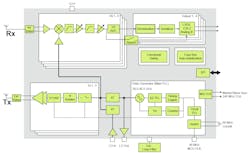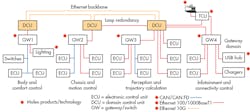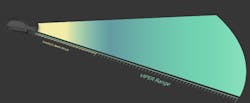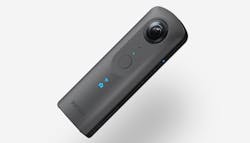Download this article in PDF format.
Most people who learn about my travel to the Consumer Electronics Show (CES) assume that I will be only checking out the latest smartphones, smart speakers, and smart cars on the show floor. I do get to a bit of that, but much of my time is spent behind closed doors where tools and products for developers can be found, such as the latest Alexa Voice Service (AVS) kit or the next automotive Ethernet switch chip. Some of what I see will show up in subsequent articles, often because the technology is shown under embargo.
That said, here are a few items I saw that I can talk about now.
MEMS Sensors
TDK was showing off a pair of new sensors. The InvenSense ICP-10100, an ultra-low-noise and ultra-low-power MEMS capacitive barometric pressure sensor, comes in a 2- × 2- × 0.72-mm waterproof package, and is good to 1.5 m. It can detect extremely small pressure differences of ±1 Pa. This allows the chip to detect altitude changes of less than 5 cm. with a temperature coefficient of ±0.5 Pa/°C. Applications include altitude hold for drones.
TDK worked with Asahi Kasei Microdevices Corp. (AKM) to develop an advanced three-axis magnetometer. It utilizes TDK’s tunnel-magnetoresistive (TMR) element and an advanced electronic compass ASIC from AKM. The system comes in a tiny 1.6- × 1.6- × 0.6-mm package. It has very low RMS noise on the order of 400 nT-rms, and it only uses 40 µA when operating at 100 Hz. The high sensitivity of 10 nT/LSB allows the sensor to detect minute changes in magnetic fields very precisely. Applications include and orientation precision such as virtual, augmented, or mixed reality (VR, AR, and MR), and indoor navigation.
Automotive Radar
Automotive technology was a central theme with NXP, revealing innovations such as the NXP Automated Drive Kit and the MR3003 Radar transceiver chip (Fig. 1). The chip has superior output power and low noise figures that enable short or long detection range. It has low phase noise, and excellent linearity enables superior separation of objects.
1. NXP’s MR3003 radar transceiver addresses the increased demand for front-view and 360-deg.-view radar.
The three transmit (TX) channels have precise phase rotators that allow each channel to transmit independently to enable detection of multiple targets simultaneously. This includes support for beamsteering. Transceiver cascading options allow multiple transceivers to be connected together inside a single radar sensor to create a high resolution, multichannel imaging radar that’s very useful in real-time environmental mapping needed for automotive applications. Such a system could be capable of tracking thousands of targets simultaneously, which is essential for level-4 and level-5 autonomous driving.
The biCMOS radar transceiver supports 76- to 81-GHz applications. It uses 4-GHz chirps for high-resolution detection of objects. The separate LO in and LO out signals support a master/slave cascade architecture. The system supports MIPI-CSI2, LVS and analog interfaces. The chips are ISO26262 and ASIL-B compliant, and come in a 7.7- × 9.2-mm WLCSP package.
Automotive Ethernet
Ethernet dominates the enterprise, office, and home, and soon to the car. Automotive Ethernet has 100-Mb/s and 1-Gb/s standards, with automotive Ethernet switches and test equipment already available to address them. However, even faster versions will be needed in the future.
2. Molex is betting that 10G Ethernet will be the backbone for automotive networks in the future.
On that front, Molex is demonstrating 10-Gb/s Ethernet (Fig. 2). This would provide the backbone for in-car communication. The slower automotive Ethernet standards would be used to link devices to the backbone. Molex’s demonstration is done in conjunction with Blackberry and its QNX Neutrino SDP 7.0 RTOS to provide secure, high-speed Ethernet communication. BlackBerry Certicom's Managed PKI (Public Key Infrastructure) Service is also part of the mix. It provides support for secure provisioning, authentication, and secure communication between modules and other vehicle ECUs and peripheral devices connected to the network.
Automotive FIR
Automotive applications have 3D LiDAR and radar at the ready, but AdaSky developed technology that may complement or compete with them. AdaSky’s far infrared (FIR) thermal VIPER camera technology provides a more robust, long-distance sensing solution that’s designed to handle all types of weather conditions (Fig. 3).
3. AdaSky uses far infrared (FIR) in its VIPER system to extend the range of its sensors beyond what’s detectable with conventional sensors.
The compact system is 2.6 cm in diameter and 4.3 cm long. The shutterless system meets Automotive SPICE (ASPICE) quality and ISO26262 safety standards. FIR is a mature technology that has been used in other areas. It’s passive and doesn’t require the emitters needed for LiDAR or radar. Moreover, FIR isn’t sensitive to direct sunlight and won’t be blinded by oncoming headlights of other vehicles. This solution provides a more compact and rugged version suitable for automotive applications.
AdaSky is definitely an outfit to watch in the automotive space.
360-Degree Cameras
One of the more fun items was the Ricoh Theta V 360-deg. camera (Fig. 4). This tiny camera can shoot 14-Mpixel, 360-deg. still photos or 4K video at 30 frames/s. The unit can plug into an advanced four-channel spatial audio microphone system. The Theta V has its own quad microphone system, but the external version is more robust. The unit even operates as a remote control for playback, although remote wireless playback requires a wireless display adapter plugged into the display or HDTV. The Theta V has Bluetooth and Wi-Fi connectivity.
4. Ricoh Theta V is an Android-based, 360-deg. camera that can shoot 4K video.
Because the Theta V is built on Android third-party plug-ins can be developed. Ricoh was highlighting its partner program and the development tools to support it, which includes the API and an SDK.
Battery-Operated Alexa
I’ve reviewed a number of development kits that target Amazon’s Alexa including the XMOS Alexa AVS Dev Kit and Cirrus Logic’s Alexa Voice Capture Development Kit for Amazon AVS. These both used a Raspberry Pi and were designed for tethered operation, although battery operation was a possibility.
Actually building a battery-powered Alexa-enabled device can be a challenge. This is why Ambiq Micro, DSP Concepts, and Sensory pooled their talents to come up with a system that can run for more than a week on a CR2032 coin-cell battery. The system is controlled by Ambiq Micro’s Apollo2 Cortex-M4 microcontroller running DSP Concepts’ Audio Weaver and Sensory’s TrulyHandsfree speech-processing software. The Apollo2 is built with Ambiq Micro’s Subthreshold Power Optimized Technology (SPOT), which provides very-low-power operation. The system is designed to always to be on and listening.
About the Author
William G. Wong
Senior Content Director - Electronic Design and Microwaves & RF
I am Editor of Electronic Design focusing on embedded, software, and systems. As Senior Content Director, I also manage Microwaves & RF and I work with a great team of editors to provide engineers, programmers, developers and technical managers with interesting and useful articles and videos on a regular basis. Check out our free newsletters to see the latest content.
You can send press releases for new products for possible coverage on the website. I am also interested in receiving contributed articles for publishing on our website. Use our template and send to me along with a signed release form.
Check out my blog, AltEmbedded on Electronic Design, as well as his latest articles on this site that are listed below.
You can visit my social media via these links:
- AltEmbedded on Electronic Design
- Bill Wong on Facebook
- @AltEmbedded on Twitter
- Bill Wong on LinkedIn
I earned a Bachelor of Electrical Engineering at the Georgia Institute of Technology and a Masters in Computer Science from Rutgers University. I still do a bit of programming using everything from C and C++ to Rust and Ada/SPARK. I do a bit of PHP programming for Drupal websites. I have posted a few Drupal modules.
I still get a hand on software and electronic hardware. Some of this can be found on our Kit Close-Up video series. You can also see me on many of our TechXchange Talk videos. I am interested in a range of projects from robotics to artificial intelligence.






